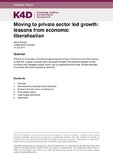| dc.contributor.author | Ferrand, Alexis | |
| dc.coverage.spatial | Uruguay | en |
| dc.coverage.spatial | Chile | en |
| dc.coverage.spatial | Turkey | en |
| dc.coverage.spatial | India | en |
| dc.coverage.spatial | Brazil | en |
| dc.coverage.spatial | Iran | en |
| dc.date.accessioned | 2019-08-08T08:59:30Z | |
| dc.date.available | 2019-08-08T08:59:30Z | |
| dc.date.issued | 2019-07-19 | |
| dc.identifier.citation | Ferrand, A. (2019). Moving to private sector led growth: lessons from economic liberalisation. K4D Helpdesk Report. Brighton, UK: Institute of Development Studies. | en |
| dc.identifier.uri | https://opendocs.ids.ac.uk/opendocs/handle/20.500.12413/14634 | |
| dc.description.abstract | Shifting to private sector led growth leads to winners and losers. Understanding which sectors of the economy and society will be affected is critical to ensure supportive policies can be put in place to reduce the costs, especially on more vulnerable populations and relevant sectors of the economy. This is also important to manage the political support for reform. Although there is relatively limited evidence either way, there is a general assumption that women, on average, benefit from successful economic liberalisation through job creation and economic opportunities.
Sequencing and speed of reforms matter; however, there is no one-size fits all approach. This depends on the country context, including whether macro-economic stabilisation is also required, how strong a political mandate is, and what institutional capacity exists to implement reform.
Shifting away from general subsidies can be part of economic liberalisation efforts, reducing distortions, freeing fiscal capacity for targeted social protection and productive investments, as well as gradually reducing fiscal liabilities. As with wider economic reform, general subsidies require careful planning and communication of their sequencing and speed and can include remedial policies and well implemented targeted cash transfers. This rapid review examines evidence on the optimal sequencing and timing of reforms for countries seeking to shift from a public to private sector-led growth models. The review includes examples of countries that have successfully done this, e.g. Uruguay, Chile, Turkey, India, Brazil and Iran. | en |
| dc.language.iso | en | en |
| dc.publisher | IDS | en |
| dc.relation.ispartofseries | K4D Helpdesk Report;647 | |
| dc.rights.uri | https://www.nationalarchives.gov.uk/doc/open-government-licence/version/3/ | en |
| dc.subject | Economic Development | en |
| dc.subject | Finance | en |
| dc.subject | Governance | en |
| dc.title | Moving to Private Sector Led Growth: Lessons from Economic Liberalisation | en |
| dc.type | Helpdesk | en |
| dc.rights.holder | © DFID - Crown copyright 2019 | en |
| dcterms.dateAccepted | 2019-07-19 | |
| rioxxterms.funder | Department for International Development, UK Government | en |
| rioxxterms.identifier.project | K4D | en |
| rioxxterms.version | VoR | en |
| rioxxterms.funder.project | 238a9fa4-fe4a-4380-996b-995f33607ba0 | en |

